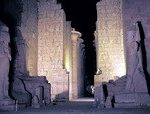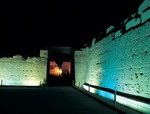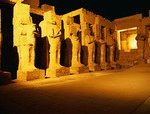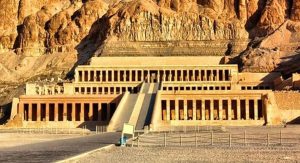The Egyptian Museum in Cairo.
Sitting in the shadows of Cairo’s modern town hall, the elegant coral-pink and copper-domed Egyptian Museum strikes a gentle pose. The restrained neo-classical French exterior is little preparation for the awesome array of treasures and ancient wonders that wait silently behind it’s arched windows.
Stepping through the entrance into the grand central atrium, monumental statues tower overhead from the imposing Colossus of Amenhotep III to King Djoser’s life-size sculpture. The ground floor galleries take you on a trip through time, each room filled with the splendors of a great kingdom. King Narmer’s 5,000 year old palette is an item of major artistic and historical importance.
Ancient Egypt’s cultural wealth is also shown in many other artifacts that reveal the skill of ancient artisans.
But it’s the upper floor that holds the greatest allure. The Tutankhamun Galleries house over 1,700 items including Tutankhamun’s famous tomb, discovered in the Valley of the Kings in West-Thebes, opposite modern Luxor.
The Egyptian Museum is just simply unrivalled with over 136,000 items on display, not mentioning the hundreds of thousands in the basement. These items date back to the very origins of a united Egypt in 3,100 BC. The museum is renowned for holding the finest collection of Egyptian antiquities in the world
Salah El Din Citadel
The Citadel of Saladin is the most popular tourist attractions in Cairo which houses a number of museums, ancient mosques and other sites, located on a spur of limestone that had been detached from its parent Moqattam Hills by quarrying. The Citadel is one of the world’s greatest monuments to medieval warfare, as well as a highly visible landmark on Cairo’s eastern skyline. Particularly when viewed from the back side (from the north), the Citadel reveals a very medieval character.
There are a lot of Mosques and museums inside the citadel like the following:
Mohamed Ali Mosque or Alabaster mosque
An-Nasir Mohammed mosque
Suleyman Pasha Mosque
Abdeen Palace & Gawharah (Jewel) Palace
Abdeen Palace
National Police Museum & Harem Palace
Abdeen Palace & Military Museum
Carriage Museum.
The Military Museum in the Saladin Citadel

The Egyptian army has had many victories and has won many battles throughout the long rich history of Egypt. Since the Pharonic era and until the modern times, the Egyptian military forces have always played a vital role in the lives of the Egyptian civilians.
The Military Museum in the Saladin Citadel in Cairo stands as the best evidence for the victories of the Egyptian army and the heroism of the Egyptian soldier who was described by Napoleon as the finest soldiers in the world.
The Museum illustrates the story of the Egyptian military forces since prehistoric times and until our modern days illustrating a large number of battles and wars where the Egyptian Army showed great skills.
The Establishment of the Military Museum
The Military Museum in the Citadel in Cairo was established in 1937 when the displays of the museum occupied only two rooms in the old building of the Ministry of Defense in Cairo. Afterwards, the museum was transferred temporary to a building in the Sheikh Barakat Street in Garden City in the year 1938.
At the end the displays of the Military Museum were relocated in its current location in Harem Palace of the Citadel of Saladin and the museum was officially open for public visits in November 1949 after two years of preparations.
Khan El Khalili Bazaars


The souk dates back to 1382, when Jaharks el-Khalili built a large caravanserai ( khan in Arabic) in Cairo under the Mamluk Sulatan Barquq; the eponymous khan is still extant. By the time of Barquq, When Barquq started his Madrasa in Bayn el-Qasrayn, markets were rebuilt, and Khan el-Khalili was established. It was also known Turkish bazaar during the Ottoman Empire.
In addition to shops, there are several coffeehouses , restaurants, and street food vendors distributed throughout the market. The coffee shops are generally small and quite traditional, serving Arabic Coffee, Tea and all soft drinks also usually offering Shisha.
Al Hussain Mosque is also in Khan el-Khalili, also you can see Al Azhar mosque in the area as it not far away.
El-Tanoura Sufi Dane


The show features members of a local Sufi sect playing traditional instruments such as various drums, cymbals, and flutes. The show also showcases dancing by whirling dervishes. The whirling dervish is said to have originated in Turkey, but is a common practice among Sufis. The dervishes twirl in circles wearing brightly colored and patterned skirts, that when spun produce hypnotic patterns. The dervishes will spin for 45 minutes continuously, varying their pace to match the music, then stop and be completely fine.
EL Sawy culture wheel

El-Sawi cultural centre in Zamalek is one of the most interesting venues in Cairo. In their two halls, the River Hall and the Wisdom Hall they offer Concerts, Movie Screenings, Performing Arts, Conferences, Poetry Readings, Seminars, Exhibitions, you name it. Every evening something is going on. Local famous bands regularly perform there.
El Sawy Culture wheel operates all year round, seven days a week from 8 am till the last show ends, offering two to four events a day. It provides culture and art at affordable prices. On an average day about 1500 people visit us, on special days the number may exceed 2000. This results in nearly 500000 visitors a year. In 2009, El Sawy Culture wheel is organizing 25 festivals and contests.
Sound & Light Show at the Giza Pyramids
Tour Highlights


Music, lights and dramatic storytelling bring the ancient Pyramids of Giza to life in this unique and memorable evening extravaganza.
Overview
Music, lights and dramatic storytelling bring the ancient Pyramids of Giza to life in this unique and memorable evening extravaganza.
The mystical sphinx takes you on a narrated journey through Egypt’s amazing history and whilst you may not learn anything new if you have already visited the pyramids during the day, you cannot help
but be truly amazed by the dazzling light show and awe-inspiring backdrop of the illuminated sphinx and pyramids.
Giza Pyramids

Guarded by the familiar lone lion-bodied Sphinx are the three Great Pyramids of Giza. Over 4,000 years ago, the mummified bodies of Kings Cheops, Kefren and Mykerinos were ferried down the Nile to be buried and prepared for the journey to the afterlife within these massive monuments.
The largest, oldest and finest of all three is Cheop’s Pyramid, simply known as the “Great Pyramid”. It was the tallest structure in the world until the end of the nineteenth century (145 meters). But Kefren’s Pyramid, Cheop’s son and successor, makes a bigger first impression. On higher ground with its limestone cap still intact, it looks loftier even though it’s 4 meters shorter.
The smallest of the three, Mykerinos’ Pyramid, makes up for its size with its fine funerary and valley temples.
Saqqara Pyramids
Time has all but erased the once mighty Memphis from the Egyptian landscape, however, the city of the dead has been excavated and exhumed from the desert sands, the vast necropolis of Saqqara. Memphis is some 23km south of central Cairo, in the center of the floodplain on the western side of the Nile. Memphis was traditionally founded in 3000 BC by Menes, the legendary figure credited with the creation of a politically unified Egypt. Memphis served as the effective administrative capital of the country during the Old Kingdom and partly in later times.
It’s eleven pyramids, countless mastabas and lone Coptic monastery stretch over 7km from north to south, and span three and a half thousand years of Egyptian civilization. At its centre sits King Djoser’s “Stepped” Pyramid, the very first pyramid and the first great stone structure in the world. North of the pyramid, inside a stone “serdab”, sits the Ancient Pharaoh himself.
Saqqara also includes the Serapeum, represented by a life-sized sculpture of limestone, the original of which is in the Egyptian Museum in Cairo, and an astonishing collection of mummified Apis bulls in gargantuan granite coffins. Of its eleven pyramids, King Teti boasts the best preserved burial chamber, with pyramid text lined walls mapping out his journey to the afterlife. The walls of Mereruka’s multichambered maze-like tomb are covered with exquisite murals, showing scenes of everyday life.
Al Azhar park




Located in the heart of old historic Cairo and commanding stunning panoramic views of the world’s most intriguing city, Al-Azhar Park offers every visitor a glimpse into the captivating past. Lush green landscaped gardens are an enjoyable sojourn away from city’s major tourist attractions. Embracing valuable history, the park is home to the newly discovered Ayyubid wall, constructed by Salah El Din more than 800 years ago.
Trip to EL Moaez street

Enjoy a wonderful walking tour at EL Moaez street in Islamic Cairo, one of the best medieval architectural treasures in the Islamic world to visit Al Azhar mosque, it was the first mosque established in Cairo, then continue to Bab Zuweila, a medieval gate in Cairo, which is still standing in modern times and it is considered one of the major landmarks of the city and then cross the road to Al Hussein Mosque, it is named for the grandson of Prophet Muhammad and it is one of the holiest Islamic sites in Cairo ( dinner at local restaurant with tasty food included) Continue walking to Al Hakim it consists of an irregular rectangle with four arcades surrounding the courtyard and to Bab El Fetouh and Bab El Nasr and by Fatimid general Jawhar as-Siqilli, is a massive fortified gate with rectangular stone towers flanking the semicircular arch of the eastern Portal, from there to Mosque-Madrassa of Sultan Hassan, a remarkable for its fantastic size and innovative architectural components, continue walking to Al Rifa`I mosque, next to Mosque of Ibn Tulun, the oldest mosque in the city surviving in its original form, and is the largest mosque in Cairo in terms of land area.
The Temple of Karnak

The most important place of worship in all Egypt during Theban power. It was built, dismantled, restored, enlarged and decorated by several pharaohs. It’s a complex of sanctuaries, obelisks and pylons, dedicated to the glory of the pharaohs. It’s a gigantic site : 1.5km by 800m. Impossible to describe, this immense monument has to be seen, to be believed.
The Temple of Luxor

Though Ramses II’s triumphant twin statues stand sentry at its entrance, it was Amenhotep III who built the bewildering Temple of Luxor. Over the years, several of Egypt’s legendary rulers added to the glory of the Temple of Luxor, from Tutankhamun to Alexander the Great.
The horse carriage in Luxor
The horse carriage is in the oldest method of transportation which was considered one of the royalties at the ancient times Explore Luxor city visit el-souk area or the local shopping areas in Luxor where you can buy the upper-Egyptian harebells, perfumes, silver and the gold souvenirs, local guide and ride the horse carriage for the way back to your Hotel.
The Temple of Queen Hatshepsut (Thebes)
At the base of a lofty limestone mountain in the desert at Thebes nestles Queen Hatshepsut’s astonishing terraced temple. Hatshepsut was Egypt’s greatest female Pharaoh. She fought off male pretenders to her throne for over 20 prosperous and peaceful years.
Partly embedded into the mountain itself, the temple is almost forty meters wide. Its honeycomb colonnades pick up the natural lines and recesses of its mountainous backdrop. Hatshepsut’s temple is essentially an extension of Mentuhotep II’s temple, though several times its size. The two blend in so well together, they are indistinguishable from a distance
The Valley of the Kings (Thebes)
Inconspicuous and unassuming, the Valley of the Kings hides its secrets well. The grand pyramids of the earlier pharaohs proved too tempting to grave robbers, so from the eighteenth to twentieth Dynasties, 26 pharaohs opted to build their tombs in the valley. Carving them deep into the mountains, far from reach, Tutankhamun, Ramses the Great and Tuthmosis III’s tombs lie in this single, sprawling necropolis. There are interesting tombs to see in the Valley of the Queens and the Valley of the Nobles as well.
Memmnon Colossi
In 18th Dynasty king Amenhotep III built a temple in west bank at Luxor that was guarded by two gargantuan statues on the outer gates. Because of nature and ancient tourists statues of Amenhotep III. Though damaged but the statues are still impressive.
This Statue is known locally as “el-Colossat”, or Colossi Memnon The statues are made from carved blocks of quartzite quarried either at Giza or Gebel es-Silsila. The Northern statue depicts Amenhotep III with his mother, Mutemwia, while the southern statue is of Amenhotep III with his wife, Tiy and one of his daughters. On the sides of the statues are relieves depicting Nil gods joining together plants symbolizing Upper and Lower Egypt.
Temple of Ramesseum
This temple of King Ramsses II it’s main building where the funerary cult of the king was celebrated was a typical stone-built New Kingdom temple. It consisting of two successive courtyards with pylon entrances, and a hypostyle hall with surrounding annexes. The pylons, some of the oldest examples of such structures, are decorated with scenes from the Battle of Kadesh. These scenes show Ramesses fighting the Hittites. He is depicted in a heroic counterattack, standing in his chariot firing arrows with deadly precision at the fleeing Hittites.
The second court is much more complete then the first. It is flaked both east and west by pillarered porticos with Osiride statues of Ramesses. These statues show Ramesses being summoned to rebirth in anew life, tightly wrapped in a shroud with his arms crossed, holding his scepters.
Tour Highlights






Watch in awe at the bright illuminations reflecting off the water and lighting up the sky as the ancient splendor of Thebes comes back to glorious life.
Overview
Watch in awe at the bright illuminations reflecting off the water and lighting up the sky as the ancient splendor of Thebes comes back to glorious life. Experience the world famous Sound and Light show at Karnak Temple on the bank of the River Nile. This unique show narrates the story of the temple and the history of Thebes, including the lives and celebrated achievements of the great pharaohs who built the necropolis. As you wander around the illuminated monuments and towering obelisks, marvel at the sheers size of the great hypostyle hall and view the eerie reflection of the temple at the Sacred Lake, the setting for a dramatic finale to the show.
Animal Hospital Luxor



Since it was founded 70 years ago the Brooke Hospital for Animals has helped millions of working horses, donkeys and mules and the countless people who depend upon them.
Animal care facility
In 1930, the founder, Mrs. Dorothy Brooke, while on a trip to Cairo, she encountered thousands of ex-cavairy horses being used as beasts of burden on its streets. On her return to England she wrote a letter to the Morning Post — which later became the Daily Telegraph — exposing their plight and appealing for funds to help her save them.
Donkeys in rehab
The public was so moved they responded with the equivalent today of £20,000 to help end their suffering.
Within three years, Mrs. Brooke had set up a committee to help fund the purchase of 5,000 of these tragic animals. Most were old and in the final stages of collapse and had to be humanely destroyed. But, thanks to this remarkable woman, they all ended their lives peacefully with love and dignity.




















